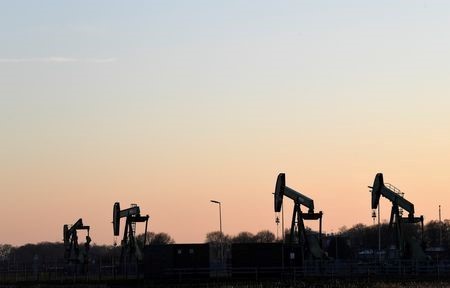




Quarterly Economic Growth Release: More BSP cuts to come
 DOWNLOAD
DOWNLOAD

Monthly Economic Update: Fed catches up
 DOWNLOAD
DOWNLOAD

Inflation Update: Steady and mellow
 DOWNLOAD
DOWNLOAD


UPDATE 9-Oil settles up on China demand hopes, posts weekly gain

Updates with closing prices, analyst comment
By Shariq Khan
BENGALURU, March 3 (Reuters) – Oil prices recovered from a brief sell-off to gain by more $1 per barrel on Friday and ended the week higher, driven by renewed optimism around demand from top oil importer China.
Brent crude futures LCOc1 rose $1.08, or 1.3%, to settle at $85.83 a barrel. U.S. West Texas Intermediate (WTI) crude CLc1 futures settled at $79.68 a barrel, up by $1.52, or 1.9%. Both benchmarks posted their highest closing levels since Feb. 13.
Prices dropped early by more than $2 per barrel after a media report said the UAE had held internal debates on leaving OPEC and pumping more oil. Prices rebounded when two sources with direct knowledge told Reuters the report was “far from the truth”.
Brent and WTI notched their third biggest weekly percentage gains this year as strong Chinese economic data fed hopes for oil demand growth.
“Crude has been on a rollercoaster today, charging lower on rumors of UAE leaving OPEC+ before reversing sharply and rocketing higher as this rumor was disputed, and crude hopped on board the risk-on rally instead,” said Kpler analyst Matt Smith.
China‘s service sector activity in February expanded at the fastest pace in six months, and manufacturing activity there also grew. China’s seaborne imports of Russian oil are set to hit a record high this month.
China, the world’s top oil importer, is getting more ambitious with its 2023 growth target, aiming as high as 6%, sources told Reuters.
The oil market broadly shrugged off a 10th consecutive week of U.S. crude stock builds USOILC=ECI, and record exports of U.S. crude lent more support to prices, UBS analyst Giovanni Staunovo said.
The dollar weakened, and analysts polled by Reuters expect the greenback to be under pressure over the next 12 months, which would make dollar-denominated oil cheaper for holders of other currencies. .DXY, =USD
The European Central Bank was still sending hawkish signals, with ECB Governing Council member Pierre Wunsch saying its key interest rate could climb as high as 4% if inflation remains high.
(Reporting by Shariq Khan
Additional reporting by Shadia Nasralla, Sudarshan Varadhan and Muyu Xu;
Editing Kirsten Donovan, David Goodman, Louise Heavens, Paul Simao and David Gregorio)
((Shariq.khan@thomsonreuters.com; Twitter: @shariqrtrs))
This article originally appeared on reuters.com





 By Reuters
By Reuters